Ever wondered what determines which videos get placed at the top of TikTok search results pages? That’s TikTok SEO — and now that more and more users are using TikTok as a search engine, optimizing your videos for search results is more important than ever.
In simple terms, TikTok SEO (Search Engine Optimization) is the practice of optimizing content so that it’s easily found by TikTok users when they’re using the search feature on the platform. Like traditional SEO, TikTok SEO involves the use of relevant and high-volume keywords that users are likely to search for. The difference between TikTok SEO and traditional SEO, however, is that TikTok SEO is a relatively new concept that is just now emerging as a way for brands and creators to take advantage of the platform’s unique audience behaviors. As TikTok SEO continues to evolve into a key consideration in any TikTok marketing strategy, we’ve nailed down the key tips that’ll help you better optimize your content to rank for TikTok’s search results.
Why Is TikTok SEO Important?
TikTok labels itself as an entertainment platform and not as a search engine, but that doesn’t stop consumers from using it as such. According to Google’s internal data, nearly 40% of Gen Z users prefer to use TikTok and Instagram over Google search. In fact, the SVP of Google himself, Prabhakar Raghavan, has said that “new internet users don’t have the expectations and the mindset that [Google] has become accustomed to”. Although Google still leads in terms of what platforms consumers find the most helpful when searching for information, TikTok is rapidly climbing that ranking. Google has confirmed that TikTok is eating into their search business, particularly amongst younger audiences that value authenticity and community-validated content.
The main impetus behind TikTok’s move into search is TikTok’s ability to provide users with valuable and engaging content that is socially validated by a community of like-minded individuals and creators. As a platform primarily driven by authenticity, TikTok inherently operates like word of mouth does (except on a global scale), meaning that it amplifies the already-high percentage of the 92% of consumers that trust word-of-mouth above all other forms of advertising. From finding customers’ reviews of the latest Dyson hairdryer or the best date night spots in New York City, users are going to TikTok for information that is based on actual experiences rather than paid ads or large corporate sponsorships.
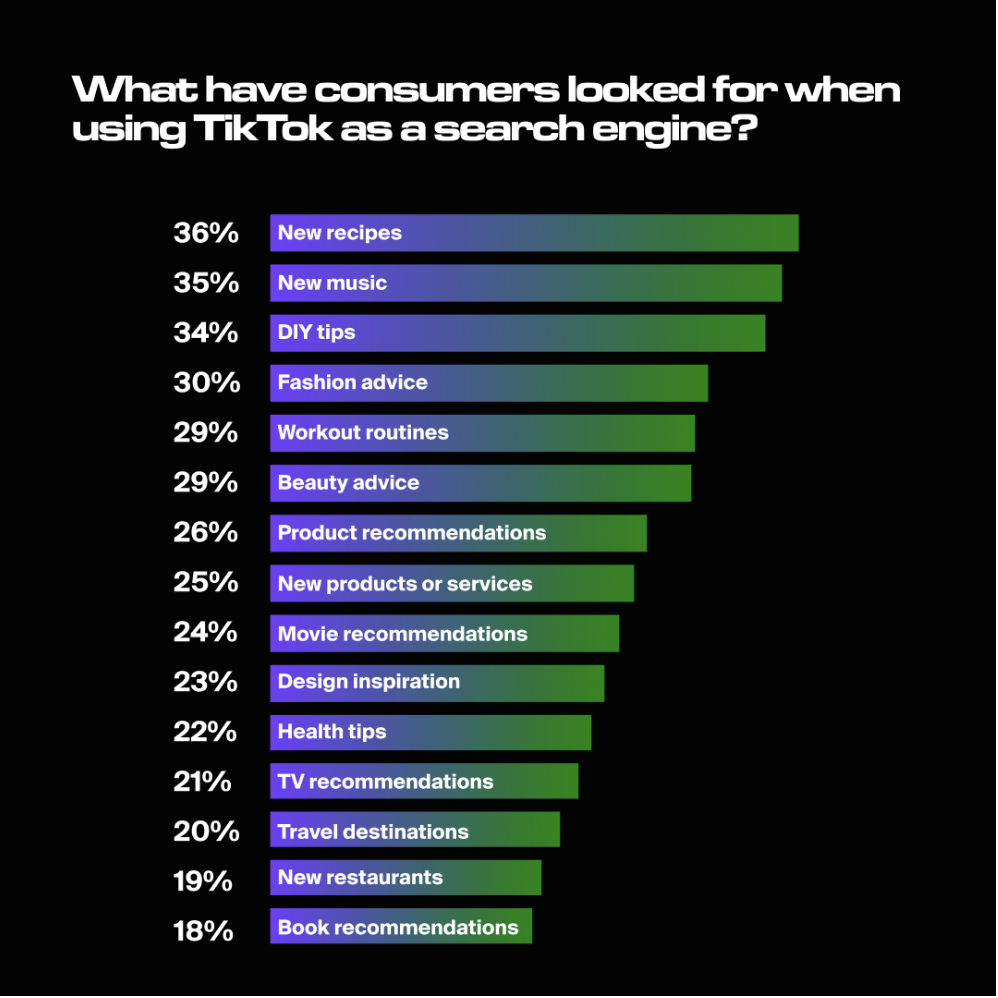
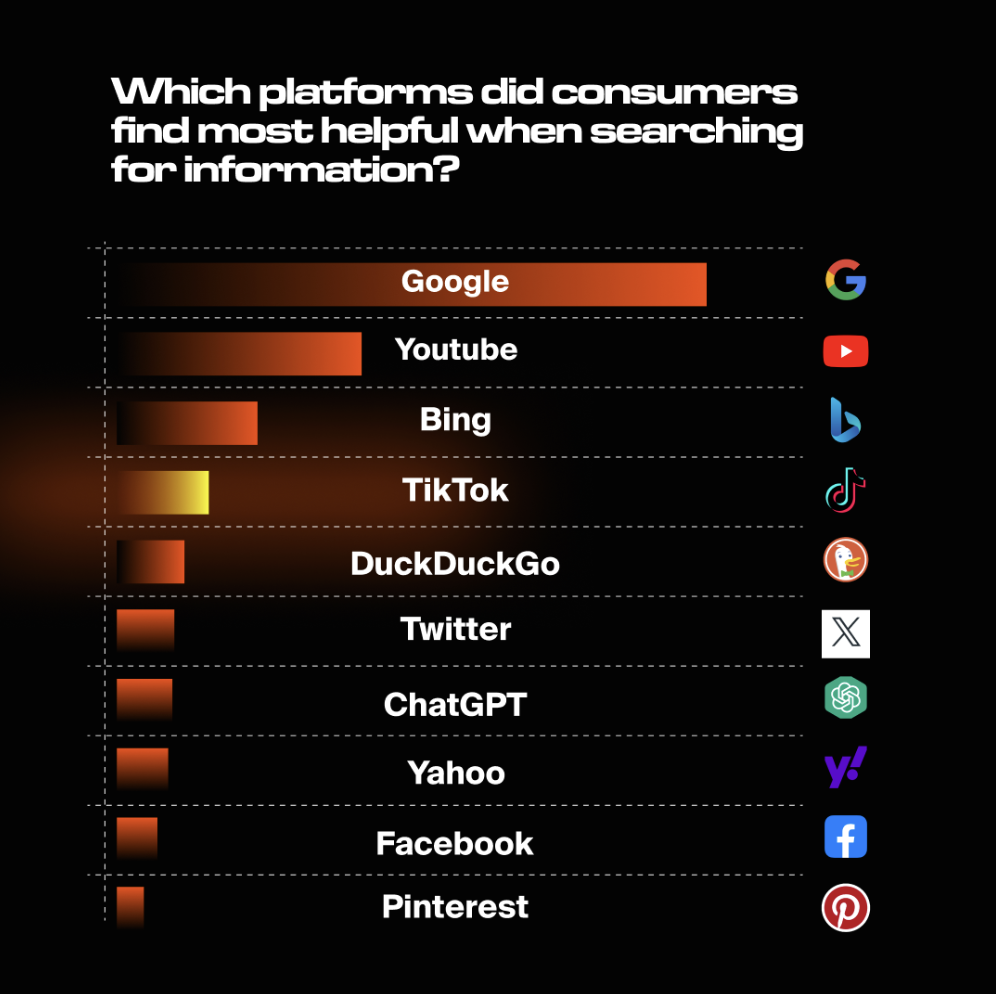
As a result of TikTok’s move into the search engine space, as well as the platform’s inherent culture of authenticity, more and more brands are turning to TikTok as a way to connect with audiences in a more direct and candid manner. This is exactly where TikTok SEO comes into play: brands and content creators need to understand TikTok SEO in order for their TikTok content to be seen by the right audiences during their search process.
Taking a step back to observe the change in the search landscape, TikTok SEO is a direct result of the major shift in users’ search habits. Google’s dominating position in search has been challenged earlier in 2022 (as we predicted as early as March 2022) due to a number of factors.
1. Gen Z prefers TikTok to Google
It’s no surprise that every brand is out there trying to crack the code on how to attract and retain GenZ consumers. And rightfully so — GenZ is the most diverse generation seen to date, and they hold a collective spending power of more than $140B. With that said, the jury is still out whether brands are able to catch up with the younger generation’s evolving preferences.
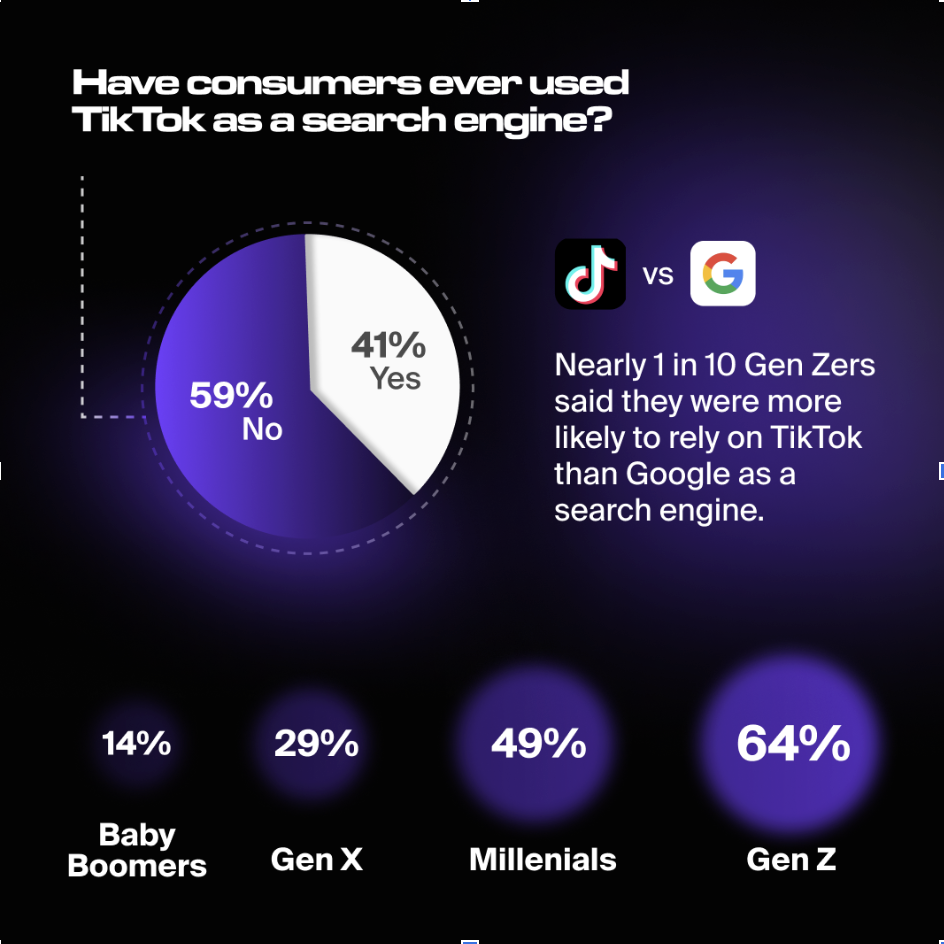
For one, it’s GenZ users who have openly opted for searching on social media rather than Google. As a generation that seeks authenticity and community, GenZ puts more emphasis and trust in community validation for the answers they seek — and a smoother visual experience that enhances the search process.
2. Savvier consumers who recognize promotions when they see them
Building off the point above, to date, GenZ is known to be the most educated generation — but with this said, the user base across social media is quickly becoming more savvy in recognizing overly promotional and engineered results to their queries and questions.
On Google, native ads allow brands who can afford to buy a higher ranking spot on the SERP to show up higher than real answers to the audience’s questions. On the other hand, brands and experts knowing how to “work” the Google algorithm through best SEO practices know how to gain higher spots for organic rankings.
For an audience that requires authentic, helpful and community-validated content in response to their questions, it’s natural to seek platforms that prioritize user-generated and approved answers.
3. The need for a better and more enriching visual experience
Social search — and TikTok specifically — fills the need for a more enriching visual experience the users seek when asking a question. Short-form video, with its authentic user-generated feel, doesn’t just provide a more visually compelling experience for those who search but also provide snackable content bites that are easy to digest and are an obvious preference over long-form blogs or web pages that take longer to consume.
Needless to say, the rise of TikTok SEO is a natural outcome of the shifts described above — it’s essential to capturing user intent where they are asking their questions today. Without further ado, let’s dive into the exact tactics to follow to boost your content’s discoverability.
How to Use TikTok Creator Insights for SEO
While TikTok wasn’t initially designed to be a search engine, the platform fully recognizes the growing importance of consumer search behaviors; they’ve since adapted their platform insights to make it easier for brands and creators to optimize their videos for search. TikTok’s Creator Search Insights is a tool that gives creators insight into topics people are searching for on TikTok, which enables them to source inspiration for their content, tailor their creative strategies to meet audience interests, or create content that people want to see more of.
One of the most interesting features of this tool is that it allows creators to filter for content gap topics — meaning topics that are searched for often, but aren’t featured in a large number of videos on TikTok. By identifying these “content gap topics”, TikTok is essentially encouraging creators to contribute to the knowledge bank available on the platform to make it more and more of a helpful, trustworthy search engine.
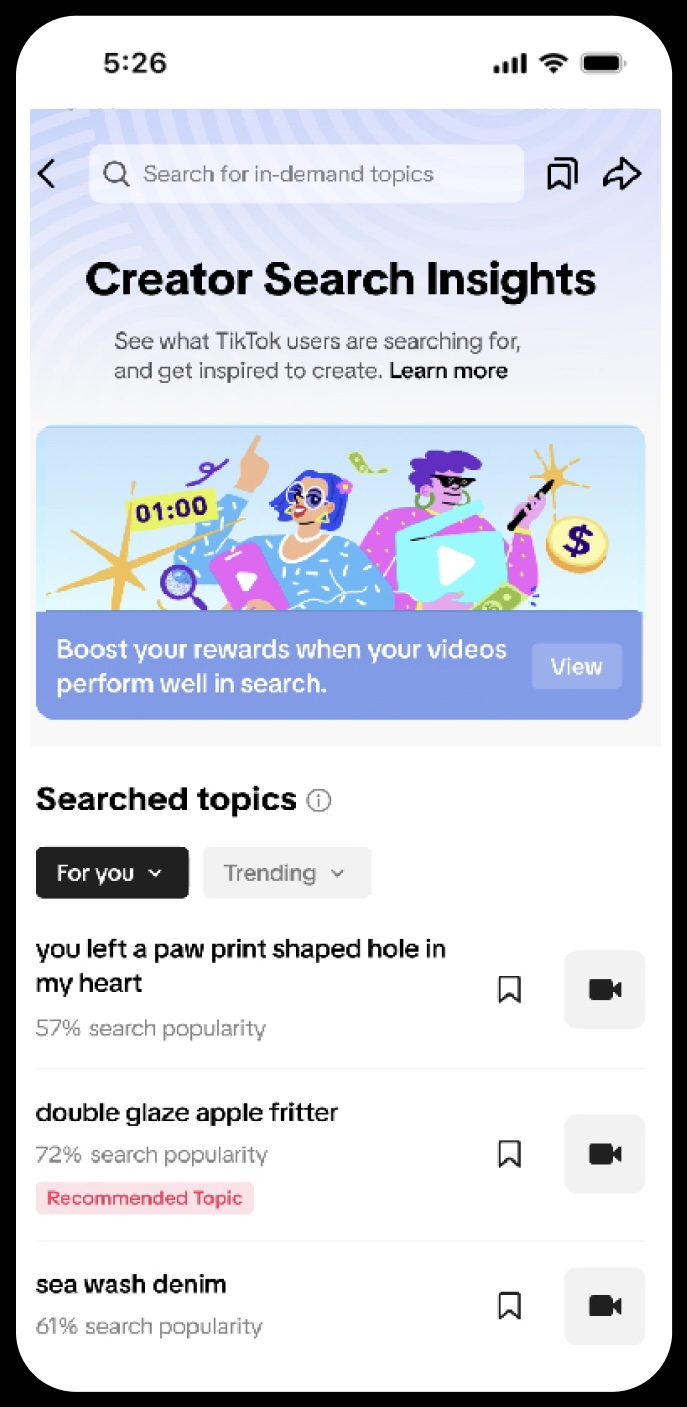
How to Rank Higher on TikTok with TikTok SEO
Here’s a simple 5-step formula for optimizing your video content for TikTok SEO:
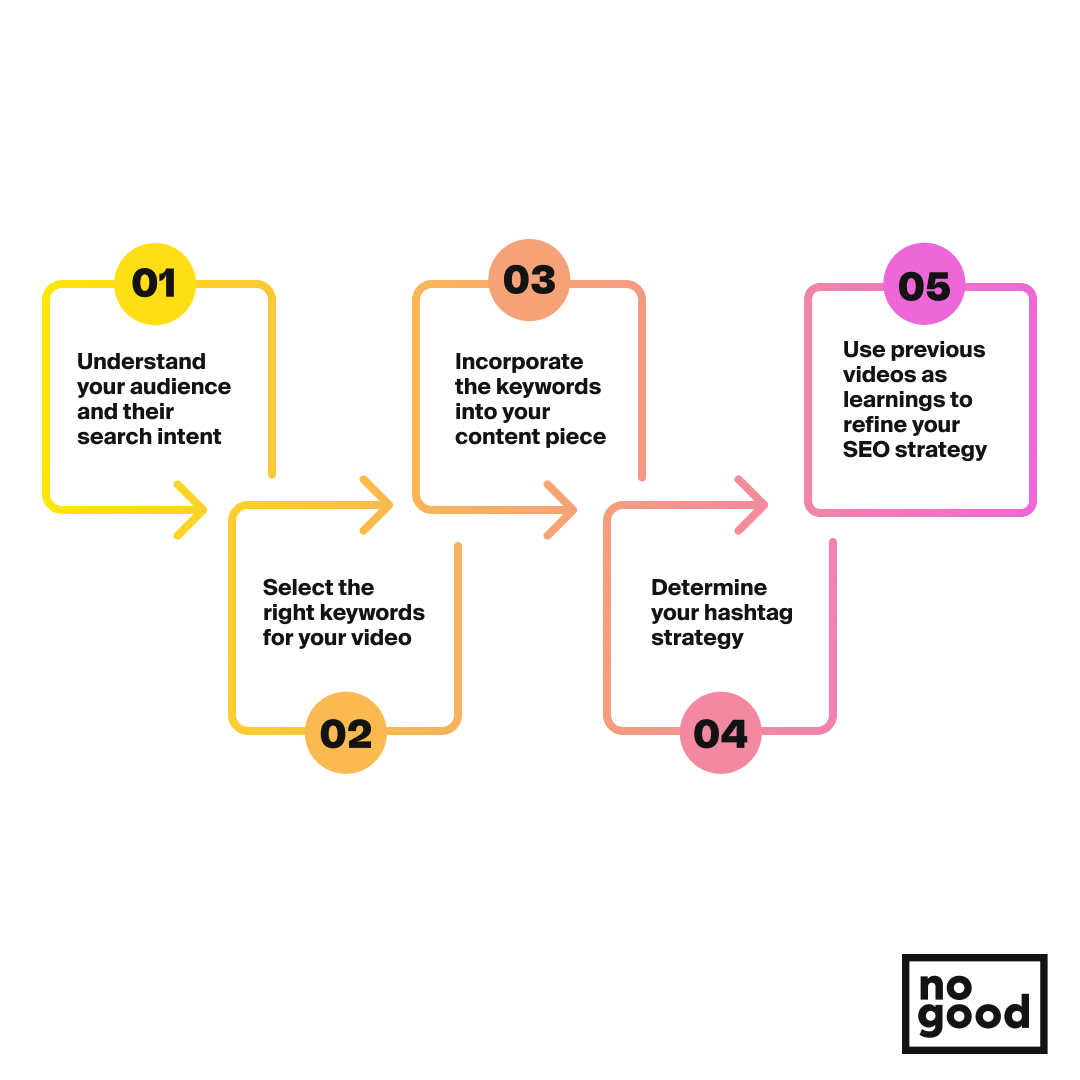
Let’s break it down step by step with an example.
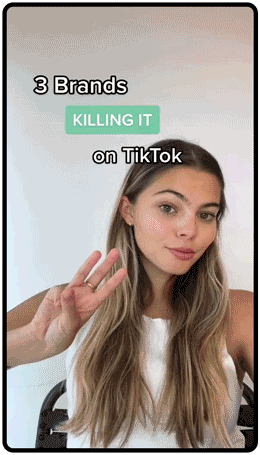
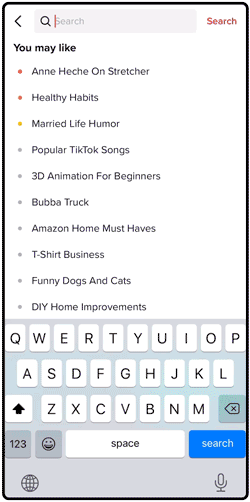
Take this video on our NoGood TikTok for example. This is a video on “3 Brands Killing It on TikTok”. It has 130,100 views and comes up as the top result when you search “brands on TikTok” in the search bar. How did we achieve this? TikTok SEO.
Step 1: Understand your audience and their search intent
Before creating your content piece, ask yourself who you’re trying to reach and what that audience might be searching for on TikTok. Are you a haircare brand looking to appeal to consumers searching for the best shampoo products for their hair type? Or are you a new SaaS company targeting small business owners that want tools to help boost their work productivity? Understanding your audience and the way your brand fits into their lives is the first step to understanding your ideal audience’s search intent. Search intent reflects the information the user is looking for during their search process, which then informs what kind of content they’d find relevant.
In our case, the NoGood TikTok audience base comprises professionals in the marketing industry who are on the lookout for growth marketing tips and industry news, and who relate to agency culture and marketing humor. Marketing professionals might be searching “brands on TikTok” to understand and learn from their TikTok marketing strategy, therefore their search intent would be to find content that analyzes what brands are doing on TikTok in order to achieve their current goals.
When doing your research, use the TikTok app to your benefit — notice how when you search for a specific term you have in mind, TikTok provides you with related keyword combinations that users are also interested in or actively searching for. Note those for yourself when developing a content strategy for TikTok as you are preparing to move on to Step 2.
Step 2: Select the right keywords for your video
Understanding your target audience and their search intent aids the next step of the process: selecting the right keywords to use in your video. There are 3 key components to consider when selecting keywords for SEO:
- Search volume = how many people are searching for your keyword
- Relevance = how relevant your content is to the keyword being searched
- Keyword difficulty = how difficult it is for your content to rank for that keyword (higher keyword difficulty means it’s a more competitive topic to rank for)
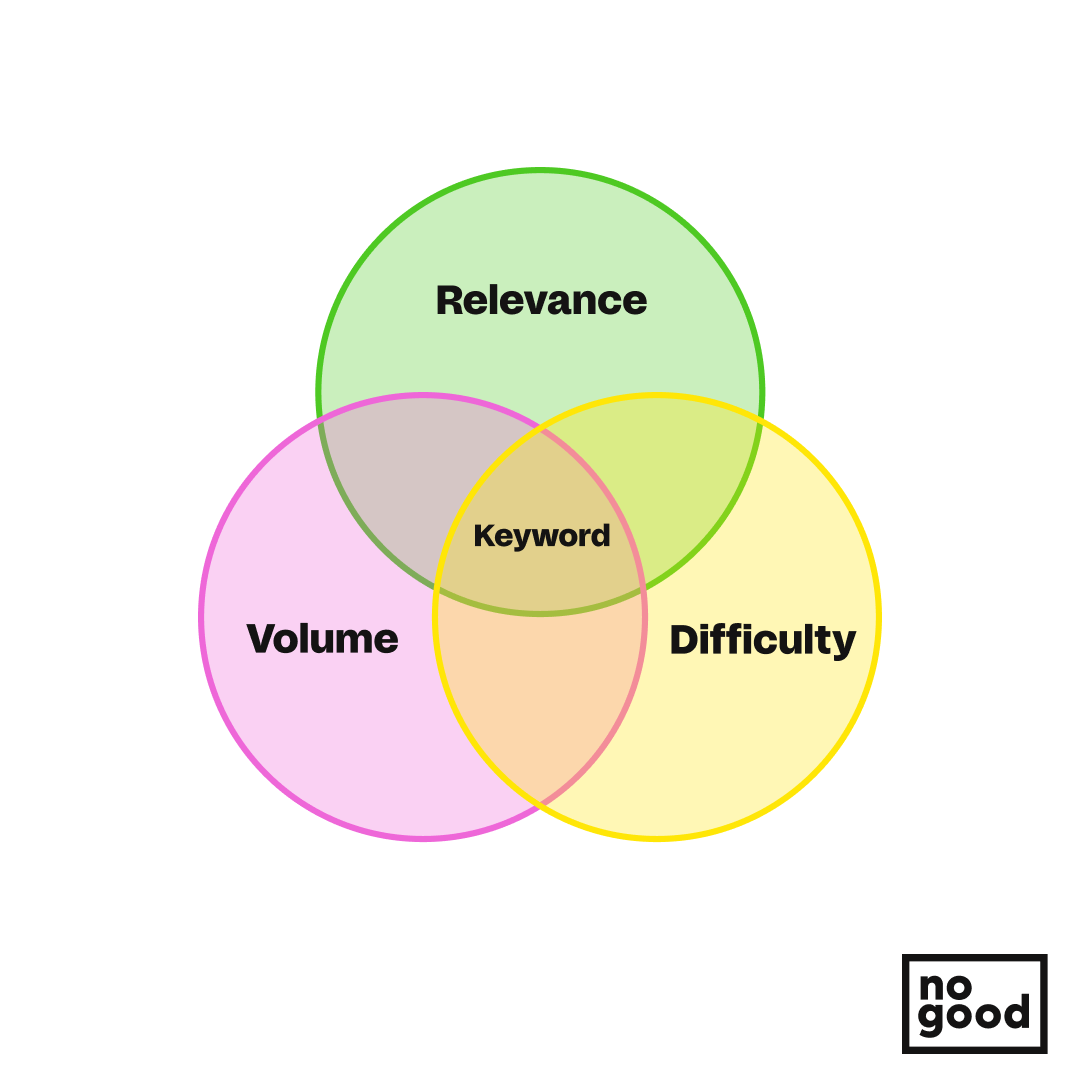
As a general rule, you want to select a keyword with:
- High search volume = this is a keyword that people are actually searching for
- High relevance = this keyword is directly related to your content
- Low keyword difficulty = this keyword is not already oversaturated with relevant content
That being said, there is no one-size-fits-all, foolproof formula for selecting the right keyword. There are instances when these three priorities of volume, relevance and difficulty might contradict one another. Aiming for a high search volume might give you high keyword difficulty, as other brands and creators are likely to have already created an abundance of content to answer that topic. Likewise, low keyword difficulty might coincide with low relevance; just because a keyword is easy to rank for does not mean that it is necessarily relevant to your content.
The only right answer to the question of what the best TikTok SEO strategy is, is: “it depends”. Here are some different strategy models for specific circumstances, depending on what stage of growth the brand is in and what the goal of the optimization is:
To reach a niche community as a smaller brand, you’ll want to choose a keyword with:
- Low-medium search volume
- High relevance
- Low keyword difficulty
To create content based on a gap in existing content in terms of relevancy or quality, you’ll want to choose a keyword with:
- High search volume
- High relevance
- Low keyword difficulty
To drive exposure and awareness to a top-of-funnel audience, you’ll want to choose a keyword with:
- High search volume
- Medium relevance
- Low keyword difficulty
The key (pun intended) to choosing the right keyword is through balancing all three aspects of volume, relevance, and difficulty, while also keeping in mind what the ultimate goal of your optimization is. Avoid over-prioritizing one aspect over the others, and make sure that your selected keyword always ties back to your audience’s search intent.
Step 3: Incorporate the keywords into your video
There are 5 ways to incorporate keywords into your TikTok videos:
- In-video text
- Speech
- Captions
- Hashtags
- Automated closed captions
And if possible, all 5 of these options should be used.
For example, in our “3 Brands Killing It on TikTok”, the keyword “brands on TikTok” is:
- As shown in the in-video text
- Spoken out loud in the video
- As mentioned in the caption
- Included as a hashtag
- Included in automated closed captions
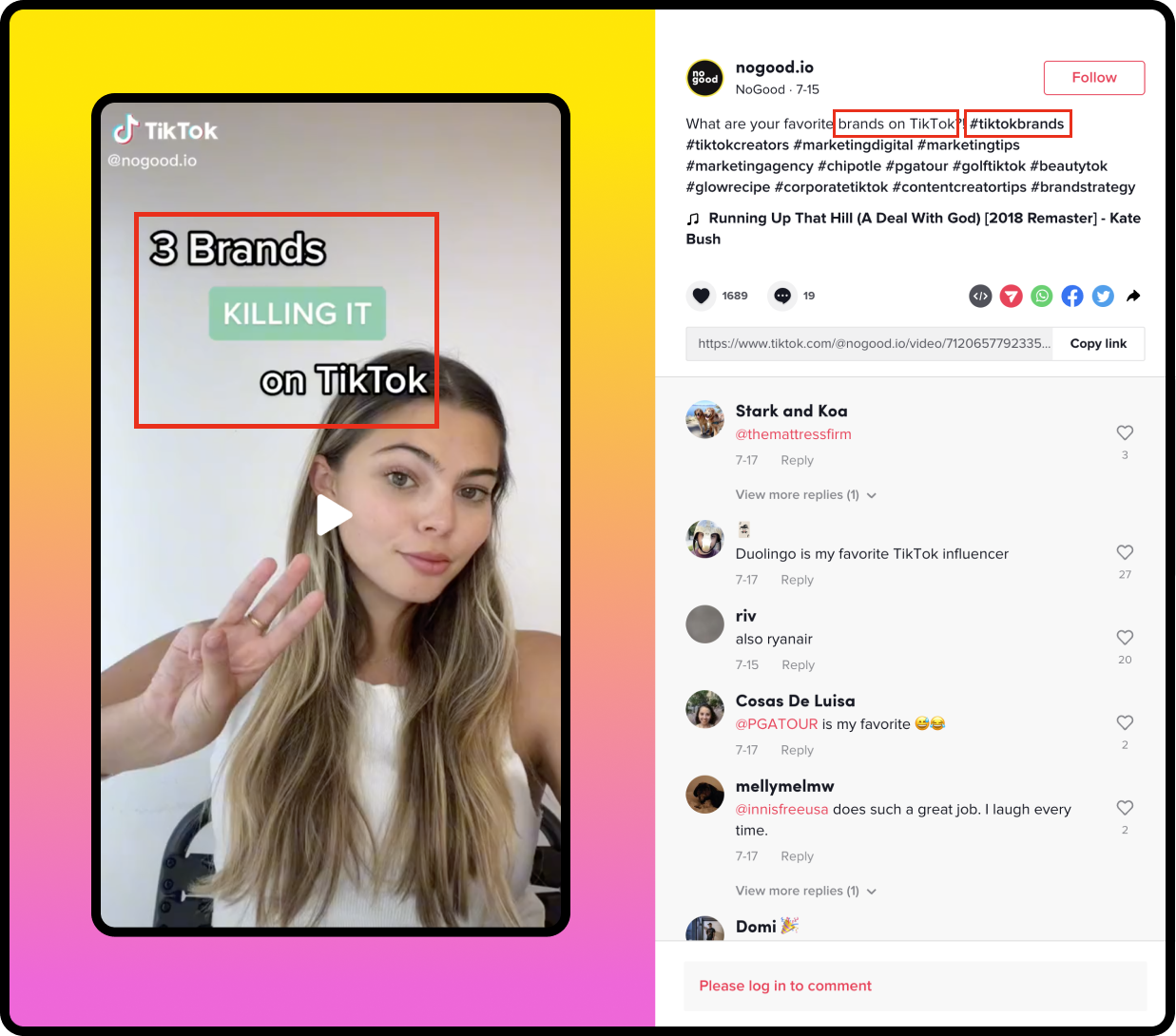
Maximizing the different ways your targeted keyword shows up in your video ensures that you are optimizing your content to rank at the top of the search results page for that keyword. The more times you mention your keyword (within reason), the more likely the platform will register your video as a relevant piece of content that’s related to your keyword.
One important thing to note here is that you want to make sure that you are mentioning your keyword in the first 3 seconds of your video, and that it shows up on the cover slide. Doing so not only lets TikTok know what the topic of your video is, but also allows your video to be easily recognized by high-intent searchers looking for information to answer their search queries.
Step 4: Determine your hashtag strategy
When it comes to creating a hashtag strategy for TikTok SEO, it’s not just “the more the merrier”. A good hashtag strategy targets both breadth and depth by incorporating a combination of long-tail and high-volume keywords.
Long-tail keywords are longer, more specific, and high-intent keywords that users are more likely to use at a later stage of their search process. These searchers are no longer casually browsing and are entering keywords with a specific action in mind, whether that be to make a purchase, to visit a location, or to answer a question.
Conversely, high-volume keywords are typically shorter, more general keywords that a large population of users is searching for. Ranking of high-volume keywords has the benefit of exposing your content to a large audience; however, search intent will be lower and conversion rates are likely to be not as strong as those of long-tail keywords.
Again, using our “3 Brands Killing It on TikTok” video as an example, you can see that in addition to our main keyword hashtag of “tiktokbrands”, we used a combination of long-tail keywords and high-volume keywords to target searchers through both relevance and volume. Keywords with lower viewcount like #contentcreatortips reach niche audiences with the specific intent of learning about content strategies, while higher volume keywords like #golftiktok target a broad audience base for purposes of reach and exposure.
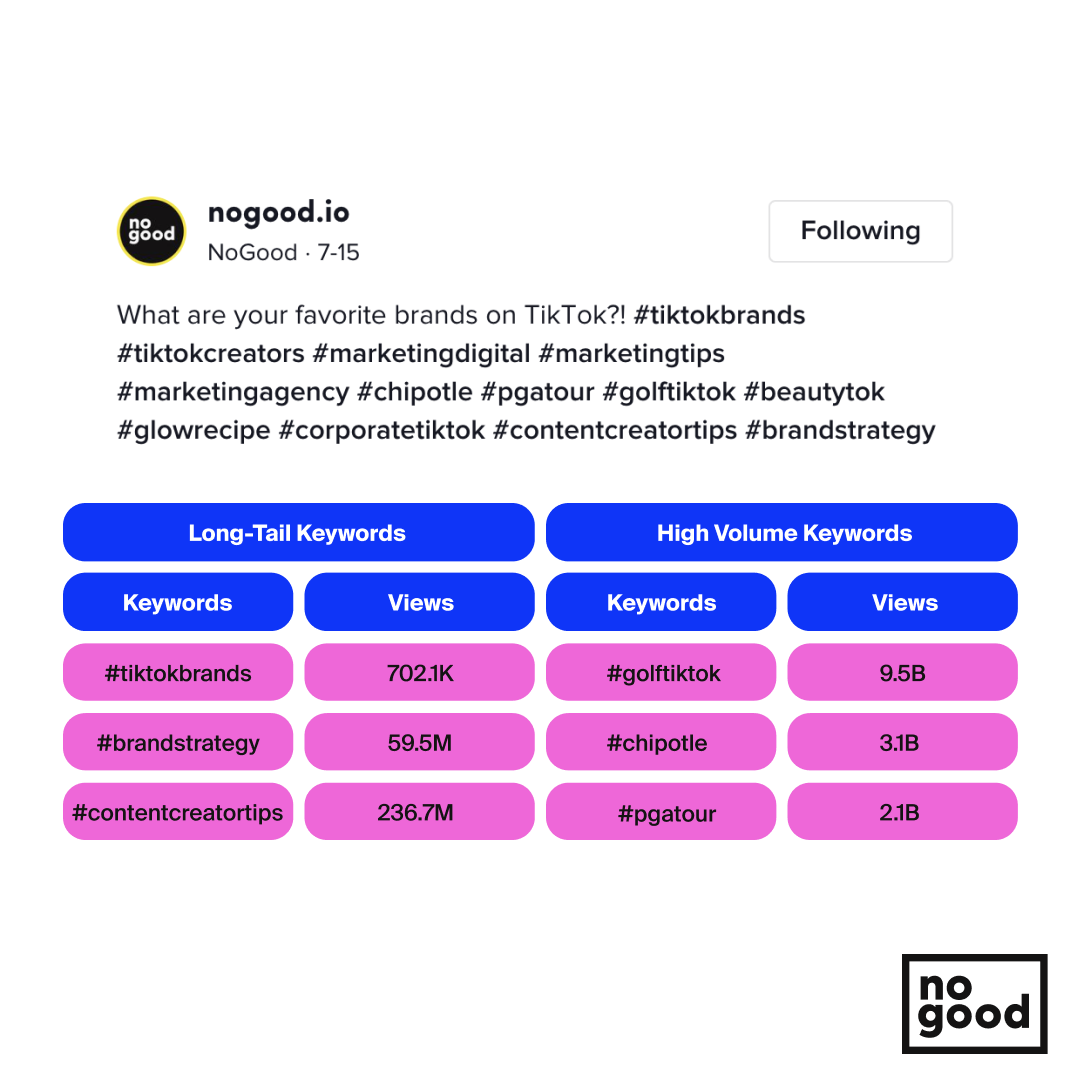
Furthermore, indexing is also a good way to utilize your hashtags and increase discoverability for certain content series. For example, if you’re planning to create a multi-part series on content creator tips, you could use the hashtag #[account name]contentcreatortips to group together multiple videos that discuss a single topic.
Step 5: Use previous videos as learnings to refine your SEO strategy
The last step is not necessarily tied to any specific video but is more of a general tip to always use previous videos as a learning tool for refining your TikTok SEO strategy for future videos. This may come in the form of reusing hashtags on successful videos, creating part 2’s of a certain topic that resonated with your target audience, or even looking at the comments of previous videos to better understand what your audience is looking for. Another opportunity for further learning is A/B testing similar hashtags or hashtags sets to determine which are actually driving traffic to your content.
Before deciding to create our “3 Brands Killing It on TikTok” video, we took learnings from our “Chrome Extensions You Can’t Live Without”, “3 AI Tools We’re Obsessed With” and “Top No-Code Tools” videos — all of which are in the top 3 ranking videos for their related keywords.
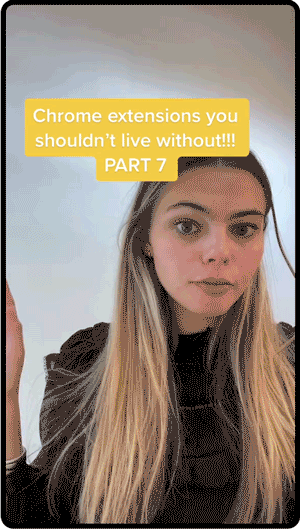
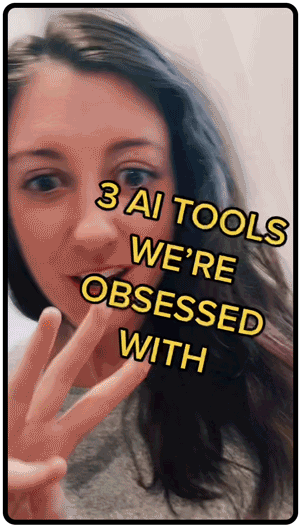

Since these videos performed well on our NoGood account, we understood that our audience enjoys marketing-related tools and content recommendations that are presented in a list format. We learned that having a catchy heading that’s both spoken and shown on-screen in the first 3 seconds works to hook users in and that the #marketingtips hashtags are consistently bringing in audiences that find our content relevant. Every audience base and every brand is different, and while it’s great to follow a tried-and-tested formula for success, the deepest learnings and most specific insights will always come from your own account’s historical data, so it’s important to leverage those learnings whenever possible.
The future of TikTok SEO
Despite being new, the future of TikTok SEO is bright. The “TikTok SEO” hashtag on TikTok already has over 26 million views, as creators and brand social media managers begin to realize the importance of optimizing their content for search. According to a report by Cloudflare, TikTok ended Google’s 15-year reign as the world’s most visited web domain in 2021. If TikTok’s rise to the top is indicative of one thing, it’s that the way users are searching for and consuming information has fundamentally changed. Consumers are no longer looking for information from the biggest or most established sources; they’re looking for information that’s visually engaging, socially validated, and authentically trustworthy — and with TikTok SEO, brands can certainly take advantage of this shift.
Whether you’re just starting to bring your brand to TikTok or you’re looking to take your brand’s TikTok SEO to the next level, we’re here to make sure your video ranks at the top. Ready to grow your brand’s TikTok account? Let’s talk.





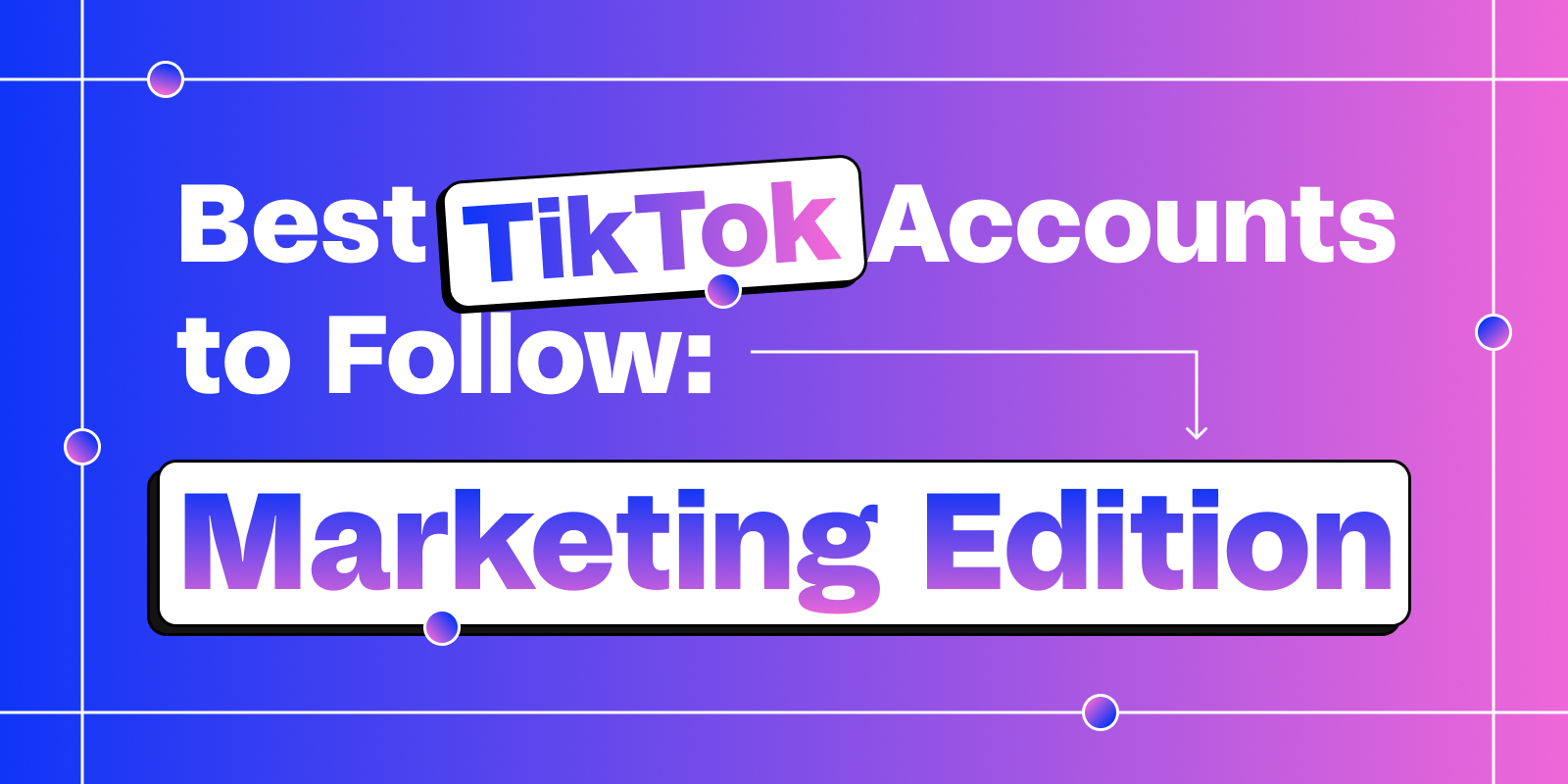

This is was the most insightful thing I read on tiktok SEO. Seems like there are plenty on opportunities on that channel. Thanks for sharing!
I saw your IG post on tiktok taking more of google search traffic from a while back and now I searched for a guide and landed here. Seems like someone is trying to own the space early. Good work.
Can I simply say what a relief to find someone who truly knows what theyre speaking about on the internet. You definitely know how to convey an issue to gentle and make it important. More people need to read this and understand this side of the story. I cant consider youre not more in style since you undoubtedly have the gift.